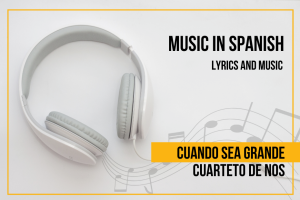Wondering what else you have to do to learn Spanish? Well, sing a song.
You can’t imagine how many benefits you will get singing in the second language you learn.
In Spanish, singing could be the strategy that makes the difference between speaking correctly and speaking correctly and adequately. Same as pronouncing clearly or like a native speaker.
We promote songs in our classes, they are a constant and, it doesn’t matter if we are good singers or not. We do it because it is an unquestionable resource in providing security and fluidity among our students.
It is not just for entertaining. It brings together in a single practice, reinforcement peculiarities and progress in three different areas:
• Linguistic and communicative resources
You will be able to recognize and acquire new vocabulary.
You will become familiar with idioms or dialect typical expressions of a region and also from a different age or social strata.
You will identify sentences at different complexity levels structures. You will reinforce the use of different tenses and temporal expressions
• Loudness
When learning a language, it is not enough to acquire words, structures, and phrases; you must also immerse yourself in phonological cadences like: pronunciation, speed, rhythm, tones, and pauses. Singing gains value, autonomously, in a class or during your learning process.
Realize that pronouncing answers in class or in a Spanish conversation practice does not have the same difficulty as doing it in speed and rhythm imposed from outside, by a sound typical structure of the target language, in this acse, Spanish.
The first time, maybe you won’t be able to repeat a sentence following the imposed pattern. However, as you repeat it, your articulation becomes more flexible and will end up accompanying the song’s metric. What does this mean for you? That you are achieving the articulatory clarity of the natives’ language at the same time with the rest of the suprasegmental elements of the language, which is called prosody.
The speed, the rhythm, the tones that form the intonation, the accent’s strengths, and the pauses, are the melodic quality of the speech, and singing makes them manifest in a more bloated way than in the speech itself. So, if you sing more, it will be less difficult for you to pronounce and you will speak more naturally.
• Cultural world
The immersion language is a cultural process more than idiomatic. The songs show the cultural world of those who produce them and their environment. Spanish songs express the point of view of Latin America or Spain artists’ poetry.
How they talk about landscapes, what they think about love, how they express themselves about the other gender, what they say about identity, what they like and what they don’t like, how they protest, what disagreements they have, why they suffer, among others.
Download an application like Lirica. They are excellent because the songs are already stored by levels; some of them have explicit content to reinforce. You can also use YouTube video with subtitles until you memorize the lyrics; although they are not classified, you will get a lot of benefit out of them.
What do I recommend to you?
Sing until you memorize, even parts of the song. The song memorization will redound its resources and its structures.
Emphasize melody, tones, and accents. A residue of that will seep into your ear and your records by the time you speak Spanish.
And finally, have you ever heard the phrase dance as if no one is watching you? Apply it to sing: Sing as if no one listens to you. Sing loud, fearless of being wrong. Resume the song even if you lose the thread. It involves gestures, hands, face. You should even exaggerate. Sing with the freedom you don’t feel when speaking. The freedom to sing, when you least expect it, will move you to the speaking accurate.
Singing makes you fall in love with Spanish.
Practice now!
I give you this song from our Venezuelan countrymen Bitoqueao. It is the A2 level. See how you can practice the conditional, imperatives, and, above all, the future.
See how you become familiar with the reductions: pa’que, or found, loqueao, alborotao. They are very frequent in informal and daily speech, do not acquire them, but it is important that you know them, and become familiar.
And also note the love declaration ways that singers make. It is a song based on the promise and love acts; typical of the Latin world, looking at the free future.
Pa ́que te enamores
Cómo quieres que te quiera dime sólo una manera
yo me invento lo que sea pa ́ que tú estés de primera Bajaré constelaciones pintaré por los rincones que eres la mujer más bella la dueña de mis pasiones Seré el príncipe del cuento te amaré cada momento mostraré todo el talento que tengo pa ́ enamorarte Todo eso y mucho más
Y si te llamo es pa ́ que te enamores
Y si te busco es pa ́ que te enamores
Y si te bailo es pa ́ que te enamores Escribo canciones pa ́ que te enamores Si te mimo es pa ́ que te enamores
Y si cocino es pa ́ que te enamores
Y si te excito es pa ́que te enamores
Te regalo el mundo pa ́ que te enamores tú
Pa ́ que te enamores tú, pa ́ que te enamores tú, pa ́ que te enamores tú tú y tú y tú y nadie más que tú
Pa ́ que te enamores tú, pa ́ que te enamores tú, pa ́ que te enamores tú tú y tú y tú y nadie más que tú
Que voy a quererte bonito
Que voy a comerte a besitos
Voy a hacerte tan feliz
que no querrás verme solito
Si quieres estar conmigo
y yo quiero estar contigo
pa ́ que vamos a inducir contradicciones al destino
Mejor vámonos de viaje
ya compré los dos pasajes
Déjate llevar
Relájate
Disfruta del paisaje
Que te voy a enamorar
Y si te llamo es pa ́ que te enamores
Y si te busco es pa ́ que te enamores
Y si te bailo es pa ́ que te enamores
Y si te escribo canciones pa ́ que te enamores
Y si te sigo es pa ́ que te enamores
Y si te excito es pa ́que te enamores
Y si cocino es pa ́ que te enamores
Te regalo el mundo pa ́ que te enamores tú
Pa ́ que te enamores tú, pa ́ que te enamores tú, pa ́ que te enamores tú tú y tú y tú y nadie más que tú
Pa ́ que te enamores tú, pa ́ que te enamores tú, pa ́ que te enamores tú tú y tú y tú y nadie más que tú
Ven acá
Que voy a enamorarte
Pa ́ darte una ma ́
Una rosa regalarte
Llevarte a una fiesta
De lo más elegante
Tú eres mi princesa
Quiero impresionarte
Bailemos hasta abajo
Con un ritmo bien loqueao
Mami eres la reina que me tiene alborotao
He viajado un mundo
Pero no te he encontrao
Una mujer tan brillante
con besos sagrados y acaramelaos
Tú pa ́ que te enamores tú, pa ́ que te enamores tú, pa ́ que te enamores tú tú y tú y tú y nadie más que tú
Pa ́ que te enamores tú, pa ́ que te enamores tú, pa ́ que te enamores tú tú y tú y tú y nadie más que tú
Di que sí que sé que sí que sí que sí.



Si con musica fue que aprendí español, es una buena idea
¡Qué bien! ¿Qué canciones te gustan?
Yes, it is very significant as the Spanish language has grown in the world and especially in the USA, currently it is a very important credential
Muy importante.
Que bien hablo un poquito español y me abre muchas puertas cuando viajo a latinoamerica
Aprender otro idioma es siempre abrir una puerta.
Very good blog but I would like you to update it more frequently
Lance you are right. I promise this is going to be fixed.
Hola Lance,
New article today, I hope you like it.
Comments are closed.